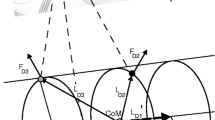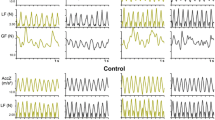Abstract
Control of isometric grip forces during manipulation of objects is an essential feature of all skilled manual performances. Recent studies suggested that the anticipation of movement-induced loads may be a cerebellar function. We analysed grip force adjustments to fluctuations of inertial loads during discrete vertical movements with a grasped object in five patients with cerebellar atrophy and five healthy control subjects. Normally grip force is precisely adapted to the load fluctuations, in particular to the maximum load force, which occurs early in upward and late in downward movements. Both groups produced similar accelerations of the grasped object and consequently similar maximum loads. However, cerebellar patients established increased static grip forces during stationary holding of the object and increased force ratios between grip and load force at the time of maximum acceleration. These findings are congruent with earlier studies analysing grip and load force coupling in patients with cerebellar lesions. In contrast to earlier studies, we found no significant differences in the timing of grip force onset and grip force maximum relative to the onset of movement and maximum acceleration, respectively, between normal controls and four of five cerebellar patients. However, a regression analysis between grip and load forces during the load increase and decrease phases of the movement suggested deficits in the close temporospatial coupling between the two forces in all cerebellar patients. Our findings give further support to the notion that the cerebellum plays a crucial role in the forward control of grip force magnitude and timing during voluntary object manipulation. Compared to earlier studies, the increase in grip forces may be interpreted as a general control strategy to compensate for motor deficits, whereas impairments of temporal grip force regulation may occur at different degrees of dysfunction during the progression of cerebellar atrophy.
Similar content being viewed by others
Author information
Authors and Affiliations
Corresponding author
Rights and permissions
About this article
Cite this article
Nowak, D.A., Hermsdörfer, J., Marquardt, C. et al. Grip and load force coupling during discrete vertical arm movements with a grasped object in cerebellar atrophy. Exp Brain Res 145, 28–39 (2002). https://doi.org/10.1007/s00221-002-1079-8
Received:
Accepted:
Published:
Issue Date:
DOI: https://doi.org/10.1007/s00221-002-1079-8




